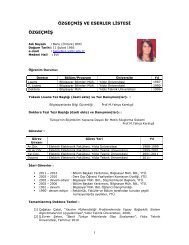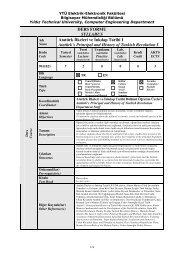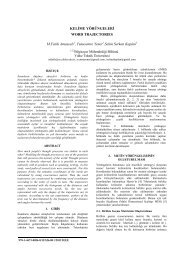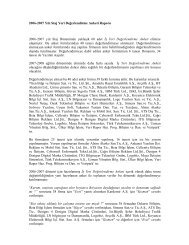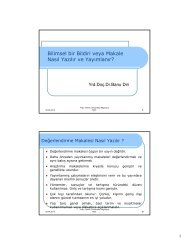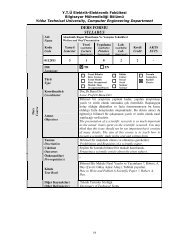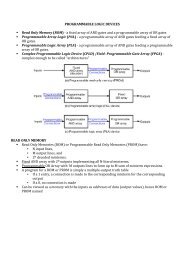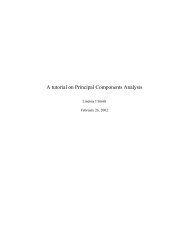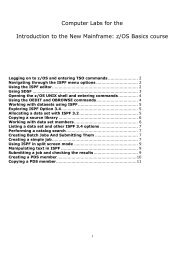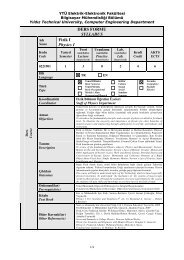Notes
Notes
Notes
You also want an ePaper? Increase the reach of your titles
YUMPU automatically turns print PDFs into web optimized ePapers that Google loves.
Hypothesis Testing<br />
• In general, many scientific investigations start by expressing a hypothesis.<br />
• For example, Mackowiak et al (1992) hypothesized that the average normal (i.e., for healthy people)<br />
body temperature is less than the widely accepted value of 98.6F.<br />
• If we denote the population mean of normal body temperature as µ, then we can express this<br />
hypothesis as µ < 98.6.<br />
Null and alternative hypotheses<br />
• The null hypothesis usually reflects the “status quo" or “nothing of interest".<br />
• In contrast, we refer to our hypothesis (i.e., the hypothesis we are investigating through a scientific<br />
study) as the alternative hypothesis and denote it as H A .<br />
• For hypothesis testing, we focus on the null hypothesis since it tends to be simpler.<br />
• Consider the body temperature example, where we want to examine the null hypothesis H 0 : µ = 98.6<br />
against the alternative hypothesis H A : µ < 98.6.<br />
• To start, suppose that σ 2 = 1 is known. Further, suppose that we have randomly selected a sample of<br />
25 healthy people from the population and measured their body temperature.<br />
• With respect to our decision regarding the null hypothesis H 0 , we might make two types of errors:<br />
o Type I error: we reject H0 when it is true and should not be rejected.<br />
o Type II error: we fail to reject H0 when it is false and should be rejected.<br />
• We denote the probability of making type I error as α and the probability of making type II error as β.<br />
• In practice, it is common to first agree on a tolerable type I error rate α, such as 0.01, 0.05, and 0.1.<br />
Decision<br />
Made<br />
Actual Validity of H 0<br />
H 0 is true H 0 is false<br />
Accept H 0 True Negative False Negative<br />
(Type II Error)<br />
Reject H 0 False Positive True Positive<br />
(Type I Error)<br />
Hypothesis testing for the population mean<br />
• To decide whether we should reject the null hypothesis, we quantify the empirical support (provided<br />
by the observed data) against the null hypothesis using some statistics.<br />
• We use statistics to evaluate our hypotheses. We refer to them as test statistics.<br />
• For a statistic to be considered as a test statistic, its sampling distribution must be fully known<br />
(exactly or approximately) under the null hypothesis.<br />
• We refer to the distribution of test statistics under the null hypothesis as the null distribution.<br />
Hypothesis testing for the population mean<br />
• To evaluate hypotheses regarding the population mean,<br />
we use the sample mean as the test statistic.<br />
~, /<br />
• For the above example, ~, 1/25<br />
• If the null hypothesis is true, then<br />
~98.6,0.04<br />
• In reality, we have one value, , for the sample mean.<br />
We can use this value to quantify the evidence of<br />
departure from the null hypothesis.<br />
• Suppose that from our sample of 25 people we find that<br />
the sample mean is 98.4<br />
• To evaluate the null hypothesis H 0 : µ = 98.6 versus the<br />
alternative H A : µ < 98.6, we use the lower tail probability of this value from the null distribution.
Observed significance level<br />
• The observed significance level for a test is the probability of values as or more extreme than the<br />
observed value, based on the null distribution in the direction supporting the alternative hypothesis.<br />
• This probability is also called the p-value and denoted p obs .<br />
• For the above example,<br />
98.4 0.16<br />
z-score<br />
• In practice, it is more common to use the standardized version of the sample mean as our test statistic.<br />
• We know that if a random variable is normally distributed (as it is the case for ), subtracting the<br />
mean and dividing by standard deviation creates a new random variable with standard normal<br />
distribution, ~0,1<br />
• We refer to the standardized value of the observed test<br />
statistic as the z-score,<br />
<br />
<br />
√<br />
<br />
98.4 98.6<br />
0.2<br />
1 0.16<br />
1<br />
• We refer to the corresponding hypothesis test of the<br />
population mean as the z-test.<br />
• In a z-test, instead of comparing the observed sample<br />
mean to the population mean according to the null<br />
hypothesis, we compare the z-score to 0.<br />
Interpretation of p-value<br />
• The p-value is the conditional probability of extreme values (as or more extreme than what has been<br />
observed) of the test statistic assuming that the null hypothesis is true.<br />
• When the p-value is small, say 0.01 for example, it is rare to find values as extreme as what we have<br />
observed (or more so).<br />
• As the p-value increases, it indicates that there is a good chance to find more extreme values (for the<br />
test statistic) than what has been observed. Then, we would be more reluctant to reject the null<br />
hypothesis.<br />
• The common significance levels are 0.01, 0.05, and 0.1. If p obs is less than the assumed cutoff, we say<br />
that the data provides statistically significant evidence against H0<br />
• For the body temperature example where p obs = 0.16, if we set the significance level at 0.05, we say<br />
that there is not significant evidence against the null hypothesis H 0 : µ = 98.6 at the 0.05 significance<br />
level, so we do not reject the null hypothesis.<br />
• if we had set the cutoff at 0.05 and we had observed 98.25 instead of 98.4, then p obs = 0.04, and<br />
we could reject the null hypothesis. In this case, we say that the result is statistically significant and<br />
the data provide enough evidence against H 0 : µ = 98.6.
One-sided vs. two-sided hypothesis testing<br />
• The alternative hypothesis H A : µ < 98.6 or H A : µ ><br />
98.6 are called one-sided alternatives.<br />
• For these hypotheses, and <br />
respectively.<br />
• In contrast, the alternative hypothesis : 98.6 is<br />
two-sided.<br />
• For the above three alternatives, the null hypothesis is<br />
the same, : 98.6<br />
• In this case, 2 ||.<br />
• Illustrating the p-value for a two-sided hypothesis test<br />
of average normal body temperature, where H 0 : µ = 98.6 and HA : µ ≠ 98.6. After standardizing,<br />
p obs = P(Z ≤−1)+P(Z ≥ 1) = 2×0.16 = 0.32<br />
Hypothesis testing using t-tests<br />
• So far, we have assumed that the population variance σ 2 is known.<br />
• In reality, σ 2 is almost always unknown, and we need to estimate it from the data.<br />
• As before, we estimate σ 2 using the sample variance S 2 .<br />
• Similar to our approach for finding confidence intervals, we account for this additional source of<br />
uncertainty by using the t-distribution with n-1 degrees of freedom instead of the standard normal<br />
distribution.<br />
• The hypothesis testing procedure is then called the t-test.<br />
• Using the observed values of and S, the observed value of the test statistic is obtained as follows:<br />
• We refer to t as the t-score.<br />
• Then,<br />
• Here, T has a t-distribution with n - 1 degrees of freedom, and t is our observed t-score.<br />
• Suppose we hypothesize that the population mean of BMI among Pima Indian women is above 30:<br />
H A : µ > 30. The corresponding null hypothesis is H 0 : µ = 30. The sample size is n = 200. The sample<br />
mean and standard deviation are = 32.31 and s = 6.13, respectively. The t-score is<br />
• For the above example, p obs = P(T ≥ 5.33), which we obtain from the t -distribution with 200 − 1 =<br />
199 degrees of freedom. The resulting probability is 1.33×10−07, which is shown as 1.33e–07. This is<br />
quite small and leads us to conclude that the result is statistically significant. At any reasonable<br />
significance level, there is strong evidence to reject the null hypothesis and conclude that the<br />
population mean of BMI among Pima Indian women is in fact greater than 30. Therefore, on average,<br />
the population is obese.
Hypothesis testing for population proportion<br />
• For a binary random variable X with possible values 0 and 1, we are typically interested in evaluating<br />
hypotheses regarding the population proportion of the outcome of interest, denoted as X = 1.<br />
• As discussed before, the population proportion is the same as the population mean for such binary<br />
variables.<br />
• So we follow the same procedure as described above.<br />
• More specifıcally, we use the z-test for hypothesis testing.<br />
• Note that we do not use t-test, because for binary random variable, population variance is<br />
σ 2 = µ(1 - µ).<br />
• Therefore, by setting µ=µ 0 according to the null hypothesis, we specify the population variance as<br />
σ 2 = µ 0 (1 - µ 0 ).<br />
• If we assume that the null hypothesis is true, we have<br />
• This means that<br />
• As a result, we obtain the z-score as follows:<br />
where p is the sample proportion (mean).<br />
• Consider the Melanoma dataset available from the MASS package. Suppose that we hypothesize that<br />
less than 50% of cases ulcerate: µ < 0.5. Then the null hypothesis can be expressed as H0 : µ = 0.5.<br />
Using the Melanoma data set, we can test the above null hypothesis. The number of observations in<br />
this data set is n = 205, of which 90 patients had ulceration. Therefore, p = 90/205 = 0.44.<br />
• Next, we can find the z-score for our test statistic as follows:<br />
• Because HA :µ
Statistical Inference for the Relationship between Two Variables<br />
• We now discuss hypothesis testing regarding possible relationships between two variables.<br />
• We focus on problems where we are investigating the relationship between one binary categorical<br />
variable (e.g., gender) and one numerical variable (e.g., body temperature).<br />
• In these situations, the binary variable typically represents two different groups or two different<br />
experimental conditions.<br />
• We treat the binary variable (a.k.a., factor) as the explanatory variable in our analysis.<br />
• The numerical variable, on the other hand, is regarded as the response (target) variable (e.g., body<br />
temperature).<br />
Relationship Between a Numerical Variable and a Binary Variable<br />
• In general, we can denote the means of the two groups as µ 1 and µ 2 .<br />
• The null hypothesis indicates that the population means are equal, H 0 : µ 1 = µ 2 .<br />
• In contrast, the alternative hypothesis is one the following:<br />
H A : µ 1 > µ 2 if we believe the mean for group 1 is greater than the mean for group 2.<br />
H A : µ 1 < µ 2 if we believe the mean for group 1 is less than the mean for group 2.<br />
H A : µ 1 ≠ µ 2 if we believe the means are different but we do not specify which one is greater.<br />
• We can also express these hypotheses in terms of the difference in the means:<br />
H A : µ 1 - µ 2 > 0, H A : µ 1 - µ 2 < 0, or H A : µ 1 - µ 2 ≠ 0.<br />
• Then the corresponding null hypothesis is that there is no difference in the population means,<br />
H 0 : µ 1 - µ 2 =0.<br />
• Previously, we used the sample mean to perform statistical inference regarding the population<br />
mean µ.<br />
• To evaluate our hypothesis regarding the difference between two means, µ 1 - µ 2 , it is reasonable to<br />
choose the difference between the sample means, 1 - 2 , as our statistic.<br />
• We use µ 12 to denote the difference between the population means µ 1 and µ 2 , and use 12 to denote<br />
the difference between the sample means 1 and 2 :<br />
µ 12 = µ 1 - µ 2 12 = 1 - 2<br />
• By the Central Limit Theorem,<br />
• Therefore,<br />
where n 1 and n 2 are the number of observations<br />
• We can rewrite this as<br />
where<br />
• We want to test our hypothesis that H A : µ 12 ≠ 0 (i.e., the difference between the two means is not<br />
zero) against the null hypothesis that H 0 : µ 12 = 0.<br />
• To use 12 as a test statistic, we need to find its sampling distribution under the null hypothesis (i.e.,<br />
its null distribution).<br />
• If the null hypothesis is true, then µ 12 = 0. Therefore, the null distribution of 12 is<br />
• As before, however, it is more common to standardize the test statistic by subtracting its mean (under<br />
the null) and dividing the result by its standard deviation.
Two-sample z-test<br />
• To test the null hypothesis H 0 : µ 12 = 0, we determine the z-score,<br />
• Then, depending on the alternative hypothesis, we can calculate the p-value, which is the observed<br />
significance level, as:<br />
The above tail probabilities are obtained from the standard normal distribution.<br />
For example:<br />
• Suppose that our sample includes n 1 = 25 women and n 2 = 27 men. The sample mean of body<br />
temperature is 1 = 98.2 for women and 2 = 98.4 for men. Then, our point estimate for the<br />
difference between population means is 12 = −0.2.<br />
• We assume that <br />
<br />
= 0.8 and <br />
<br />
= 1.<br />
• The variance of the sampling distribution is 0.8/25+1/27 = 0.07, and the standard deviation is SD 12 =<br />
√0.07 = 0.26.<br />
• The z-score is z = (-0.2 / 0.26)= -0.76<br />
• H A : µ 12 ≠ 0 and z = −0.76. Therefore, p obs = 2P(Z ≥ |−0.76|) = 2×0.22 = 0.44.<br />
• For the body temperature example, p obs = 0.44 is greater than the commonly used significance levels<br />
(e.g., 0.01, 0.05, and 0.1). Therefore, the test result is not statistically significant, and we cannot reject<br />
the null hypothesis (which states that the population means for the two groups are the same) at these<br />
levels.<br />
Two-Sample t-test<br />
• In practice, SD 12 is not known since σ 1 and σ 2 are unknown.<br />
• We can estimate it as follows:<br />
where SE 12 is the standard error of 12 .<br />
• Then, instead of the standard normal distribution, we need to use t-distributions to find p-values.<br />
• For this, we can use R or R-Commander.<br />
• The t –score<br />
• Therefore, we rarely need to calculate the degrees of freedom manually. Alternatively, we could use a<br />
conservative approach and set df to min(n 1 − 1,n 2 − 1), i.e., the smaller of n 1 − 1 and n 2 − 1.
Paired t-test<br />
• While we hope that the two samples taken from the population are comparable except for the<br />
characteristic that defines the grouping, this is not guaranteed in general.<br />
• To mitigate the influence of other important factors (e.g., age) that are not the focus of our study, we<br />
sometimes pair (match) each individual in one group with an individual in the other group so that the<br />
paired individuals are very similar to each other except for the characteristic that defines the grouping.<br />
• For example, we might recruit twins and assign one of them to the treatment group and the other one<br />
to the placebo group.<br />
• Sometimes, the subjects in the two groups are the same individuals under two different conditions.<br />
• When the individuals in the two groups are paired, we use the paired t-test to take the pairing of the<br />
observations between the two groups into account.<br />
• Using the difference, D, between the paired observations, the hypothesis testing problem reduces to a<br />
single sample t-test problem.<br />
• To test the null hypothesis H 0 : µ = 0, we calculate the T statistic,<br />
where, n is the number of pairs.<br />
• The test statistic T has the t-distribution with n - 1 degrees of freedom.<br />
• We calculate the corresponding t-score as follows:<br />
• Then the p-value is the probability of having as extreme or more extreme values than the observed t-<br />
score:<br />
where T has the t-distribution with n - 1 degrees of freedom.<br />
Example:<br />
• For the Platelet data, we want to compare platelet aggregation measurements for the same person<br />
before and after smoking. D represents the difference in platelet aggregation from before to after.<br />
• The observed value of is =−10.27. Using the sample standard deviation s = 7.98 and the sample<br />
size n = 11, the standard error (i.e., estimated standard deviation) of is<br />
7.98 2.41<br />
√11<br />
• Suppose that we are interested in 95% confidence interval estimate for µ (i.e.,population mean of the<br />
difference between before and after smoking). Using the t -distribution with n−1 = 10 degrees of<br />
freedom, we obtain t crit = 2.23. Therefore, the 95% confidence interval is<br />
, 10.27 2.23 2.4, 10.27 2.23 2.4 15.64, 4.90<br />
• At 0.95 confidence level, we believe that the true mean of the difference is between −15.64 and<br />
−4.90. Note that this range includes negative values only and does not include the value 0 specified<br />
by the null hypothesis.<br />
• To perform hypothesis testing, we find the t-score (here, µ0 = 0 according to the null hypothesis) as<br />
follows:<br />
10.27 4.26<br />
2.41<br />
• To find the p-value, we find the upper tail probability of |−4.26| = 4.26 from the t -distribution with 10<br />
degrees of freedom, and multiply the results by 2 for two sided hypothesis testing:<br />
2 4.26 2 0.0008 0.0016
• At 0.01 confidence level, we can reject the null hypothesis and conclude that the test result is<br />
statistically significant. In this case, we interpret this as a statistically significant relationship between<br />
smoking and platelet aggregation.<br />
Inference about the Relationnship Between Two Bınary Variables<br />
• A common way to analyze the relationship between binary (in general, categorical) variables is to use<br />
contingency tables. Contingency tables are a tabular representations of the frequencies for all possible<br />
combinations of the two variables.<br />
• We refer to our estimate of SD12 as the standard error and denote it as SE 12 :<br />
1 <br />
<br />
1 <br />
<br />
• Using the point estimate p12 along with the standard error SE12, we can find confidence intervals for<br />
µ12 as follows:<br />
, <br />
where z crit is obtained for a given confidence level c as before<br />
• We test the null hypothesis, H0 : µ 12 = 0, using the two-sample z-test as follows.<br />
o First, we obtain the z-score, <br />
<br />
o Then, we calculate the p-value, which is the observed significance level:<br />
if H A : µ12 > 0, p obs = P(Z ≥ z),<br />
if H A : µ12 < 0, p obs = P(Z ≤ z),<br />
if H A : µ12 ≠ 0, p obs = 2×P(Z ≥ |z|).<br />
Example<br />
• As an example, suppose that we want to investigate whether smoking during pregnancy increases the<br />
risk of having a low birthweight baby.<br />
• We denote the population proportion of low-birthweight babies for nonsmoking mothers as µ 1 , and<br />
the population proportion of low-birthweight babies for smoking mothers as µ 2 . We use µ 12 to denote<br />
the difference between these two proportions:<br />
µ 12 = µ 1 – µ 2<br />
• If smoking and low birthweight are related, we expect the two population proportions to be different<br />
and µ 12 to be away from zero. Therefore, we can express our hypothesis regarding the relationship<br />
between the two variables as H A : µ 12 ≠ 0. we use the two-sided alternative. The corresponding null<br />
hypothesis is then H 0 : µ12 = 0.<br />
• For our example, p 1 = 0.25 and p 2 = 0.40. These are the point estimates for µ 1 and µ 2 , respectively. As<br />
a result, the point estimate of µ 12 is p 12 = 0.25− 0.40=−0.15.<br />
0.251 0.25 0.401 0.40<br />
0.07<br />
115<br />
74<br />
• The 95% confidence interval of µ 12 is 0.15 2 0.07, 0.15 2 0.07 0.29, 0.01
• Therefore, we are 95% confident that the difference between the two population proportions falls<br />
between −0.29 and −0.01. Note that all the values in this range are negative.<br />
o For our example, .<br />
.<br />
2.14<br />
• Because we specified the alternative hypothesis as H 12 : µ 12 ≠ 0, the p-value is two times the upper tail<br />
probability of |−2.14| = 2.14 from the standard normal distribution, that is, p obs = 2×0.016 = 0.032.<br />
• At 0.05 level (but not at 0.01 level), we can reject the null hypothesis and conclude that the observed<br />
difference in the proportion of low-birthweight babies is statistically significant and is probably not<br />
due to the chance alone.<br />
Inference Regarding the Linear Relationship Between Two Numerical Variables<br />
• A sample correlation coefficient r for observed pairs of values:<br />
<br />
<br />
∑ <br />
1) <br />
• The t -distribution with n−2 degrees of freedom. The observed value of the test statistic is denoted t<br />
and calculated as<br />
<br />
=<br />
(1 − )/( − 2)<br />
where r is the observed correlation coefficient based on our sample.<br />
• Then we determine the amount of support against the null hypothesis as:<br />
o if H A :ρ >0, pobs = P(T ≥ t),<br />
o if H A :ρ



